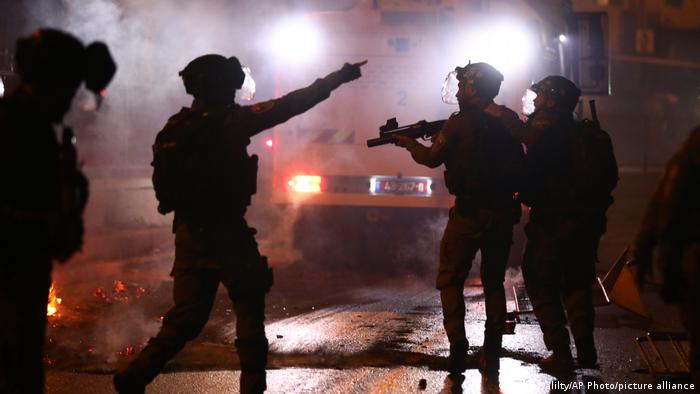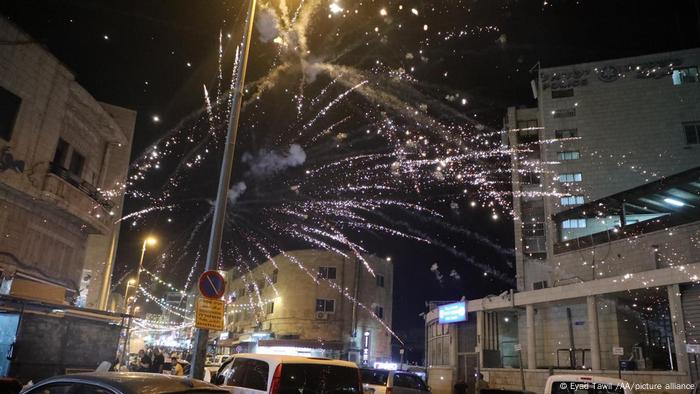Violence against Peru’s indigenous communities surges as drug traffickers move in
Issued on: 08/05/2021 -

Herlín Odicio (president of the Cacataibo native communities’ federation) and Berlín Diques (president of Orau) © Herlín Odicio/ Luis Miranda and Berlín Diques
Text by: Olivia Biz
Nine indigenous leaders in Peru’s central Amazon have been murdered in the past year and many more have received death threats as their ancestral land is seized by drug traffickers. Covid-19 restrictions have made the remote region even more vulnerable as governmental efforts to protect the land have been hindered. In the face of mounting pressure, authorities have recently taken action, but our Observers say that more needs to be done.
The latest attack was reported on April 23, 2021 in the eastern region of Ucayali, where alleged drug gangs set fire to the home of Elmer Gonzales, who belongs to the indigenous Cacataibo ethnic group. The traffickers also left a warning that read “I am Colombian. Elmer, I want my load” (see photo below). Meanwhile, Fredy Yaycate, from the same community was kidnapped and found several days later with signs of torture. They are now among a growing number of Cacataibo people who have gone into hiding, fearful for their lives.
.webp)
Warning left by traffickers that reads “I am Colombian. Elmer, I want my load” © Observers
We spoke to the President of the Native Federation of Cacataibo Communities, Herlín Odicio, who was forced into hiding in April after death threats and attacks on his land in Ucayali escalated.
The situation started to get bad last September, when a Columbian [narcos] came to my community and offered me a lot of money to collaborate with them. They were offering to give me money for every drug flight that left from a secret airstrip on my territory. I didn’t accept the offer, and since then, the death threats have gotten worse. But they already knew me, I received the first threats five years ago.
In February 2021, the government of Ucayali released a report that identified 46 clandestine airplane runways in the region, used to transport coca into neighbouring Brazil and Bolivia. The report also revealed that narcotrafficking in Ucayali caused the deforestation of 42,600 hectares of land in 2020.
We spoke to the President of the Native Federation of Cacataibo Communities, Herlín Odicio, who was forced into hiding in April after death threats and attacks on his land in Ucayali escalated.
The situation started to get bad last September, when a Columbian [narcos] came to my community and offered me a lot of money to collaborate with them. They were offering to give me money for every drug flight that left from a secret airstrip on my territory. I didn’t accept the offer, and since then, the death threats have gotten worse. But they already knew me, I received the first threats five years ago.
In February 2021, the government of Ucayali released a report that identified 46 clandestine airplane runways in the region, used to transport coca into neighbouring Brazil and Bolivia. The report also revealed that narcotrafficking in Ucayali caused the deforestation of 42,600 hectares of land in 2020.

Aerial view of an airstrip in Ucayali region © © GERFFS

When the coronavirus state of emergency began, governmental institutions stopped and the narcos took advantage of the silence to go deeper into the Amazon and assassinate more leaders. The Amazon is huge and the police cannot be everywhere. But the main problem is that the state does not work, they have not been protecting us. We’ve seen the illegal crops and maceration pits they use to make cocaine paste, and we’ve sent proof to the police. But nothing has been done.

When the coronavirus state of emergency began, governmental institutions stopped and the narcos took advantage of the silence to go deeper into the Amazon and assassinate more leaders. The Amazon is huge and the police cannot be everywhere. But the main problem is that the state does not work, they have not been protecting us. We’ve seen the illegal crops and maceration pits they use to make cocaine paste, and we’ve sent proof to the police. But nothing has been done.
.jpeg)
Suspected clandestine airstrips in 2020 © © GeoBosques
From coca to cocaine
.jpeg)
Phase 1: Forest cleared so that coca camps can be built on the land, Ucayali
.jpeg)
Phase 2: Coca cultivation, Ucayali
.jpeg)
Phase 3: Coca lab to transform plant into cocaine.
Photo taken by indigenous land monitors in Sinchi Roca,
Ucayali in May 2021.
.jpeg)
Gasoline and kerosene, ingredients used to make cocaine paste. Photo taken by indigenous land monitors in Sinchi Roca, Ucayali in May 2021.
5/6

Clandestine coca lab in Ucayali

Clandestine coca lab in Ucayali
6/6
.jpeg)
.jpeg)
Wood sold illegally and used to build coca labs.
Photo taken by indigenous land monitors in Sinchi Roca,
Ucayali in May 2021.
© The Observers
Denouncing what is happening is the only thing that I can do. For too long, our communities have had no rights, but we haven’t spoken out. It’s time for this to change. I know that I am risking my life but I will continue this fight until the last days of my existence.
The nine indigenous leaders who were murdered this year all stood up to the drug trafficking mafias in their territories. But there is another denominator in each of the cases: impunity. We spoke to Zulema Guevara, whose husband, Arbilo Meléndez, was assassinated in April 2020. Shortly after the Cacataibo leader’s death, the prosecution identified the alleged perpetrator, but he was never sentenced. More than a year later, Zulema Guevara is still demanding justice for her husband.
The nine indigenous leaders who were murdered this year all stood up to the drug trafficking mafias in their territories. But there is another denominator in each of the cases: impunity. We spoke to Zulema Guevara, whose husband, Arbilo Meléndez, was assassinated in April 2020. Shortly after the Cacataibo leader’s death, the prosecution identified the alleged perpetrator, but he was never sentenced. More than a year later, Zulema Guevara is still demanding justice for her husband.
Justice is not happening even though they have all the cards in their hands. The person who killed my husband is still free and it looks like he could remain free. I seek justice not only for my husband, but for all the leaders who are being killed and for their widows and children that they have left behind. (...) Our communities are being abandoned.
Zulema Guevara has been receiving death threats from the same group of people who killed her husband. In an attempt to save her life and those of her children, she has gone into hiding with her family.
Such stories are becoming increasingly common and have prompted indigenous organisations and the land defenders at risk to launch an emergency campaign to draw the government's attention.
The government takes welcome but 'superficial' action
Responding to pressure from these indigenous communities, as well as from the US, Norway and the UN, the Peruvian government announced the creation of an "intersectoral mechanism" in April, under which various sectors of the government would come together to protect the human rights of defenders.
Although these initiatives are a step in the right direction, indigenous leaders say the mechanism is a superficial solution to the problem
Berlin Diquez, president of the regional indigenous organisation ORAU, told us that until the government makes a commitment to assist tribes in obtaining legal titles to ancestral land, the violence would continue unmitigated.
Until we own something that is legally recognised, we will keep on fighting, because until that moment, justice will not be served.
No man’s land
Ucayali is vulnerable to land invasions, as many of its indigenous communities don’t have legal titles to their ancestral territory. To procure these titles, tribes must navigate their way through a complex procedure that can take decades.
Meanwhile, the process of titling individual properties is much faster, which has encouraged outsiders, with the government’s support, to buy land in indigenous territories.
The FRANCE 24 Observers team spoke to Lavaro Masquez, a lawyer specialising in indigenous rights at Lima’s Legal Defence Institute.
Titling is the most important problem facing indigenous communities in Peru. One of the cases I am working on at the moment concerns a tribe that has been requesting titles to its land for 25 years, but they still haven’t been given legal ownership to what is rightfully theirs. In the meantime, drug trafficking and other illegal activities have spread and are threatening the community.
There is structural discrimation and racism against indigenous communities in our country. The government does not prioritise indigenous cases as the balance is tipped in the favour of those who have money.
Indigenous people are risking their lives to stop the proliferation of coca and to protect their land. It’s time to give them the importance that they deserve. We need to give them their land back.
The difficulties that Peruvian indigenous communities face in obtaining land titles is not unique to Peru. Indigenous peoples and rural communities occupy more than half of the world’s land, but they legally own just 10 percent of it.
A special thanks to Gabrielle Colchen and Laura Peña Silva for their help translating the interviews.
Until we own something that is legally recognised, we will keep on fighting, because until that moment, justice will not be served.
No man’s land
Ucayali is vulnerable to land invasions, as many of its indigenous communities don’t have legal titles to their ancestral territory. To procure these titles, tribes must navigate their way through a complex procedure that can take decades.
Meanwhile, the process of titling individual properties is much faster, which has encouraged outsiders, with the government’s support, to buy land in indigenous territories.
The FRANCE 24 Observers team spoke to Lavaro Masquez, a lawyer specialising in indigenous rights at Lima’s Legal Defence Institute.
Titling is the most important problem facing indigenous communities in Peru. One of the cases I am working on at the moment concerns a tribe that has been requesting titles to its land for 25 years, but they still haven’t been given legal ownership to what is rightfully theirs. In the meantime, drug trafficking and other illegal activities have spread and are threatening the community.
There is structural discrimation and racism against indigenous communities in our country. The government does not prioritise indigenous cases as the balance is tipped in the favour of those who have money.
Indigenous people are risking their lives to stop the proliferation of coca and to protect their land. It’s time to give them the importance that they deserve. We need to give them their land back.
The difficulties that Peruvian indigenous communities face in obtaining land titles is not unique to Peru. Indigenous peoples and rural communities occupy more than half of the world’s land, but they legally own just 10 percent of it.
A special thanks to Gabrielle Colchen and Laura Peña Silva for their help translating the interviews.

















 © Provided by CBS News / Credit: NOAA
© Provided by CBS News / Credit: NOAA



